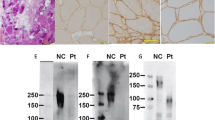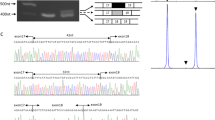Abstract
Autosomal recessive limb-girdle muscular dystrophies (AR LGMDs) are a genetically heterogeneous group of disorders that affect mainly the proximal musculature1. There are eight genetically distinct forms of AR LGMD, LGMD 2A–H (refs 2–10), and the genetic lesions underlying these forms, except for LGMD 2G and 2H, have been identified. LGMD 2A and LGMD 2B are caused by mutations in the genes encoding calpain 3 (ref. 11) and dysferlin12, respectively, and are usually associated with a mild phenotype11,12,13. Mutations in the genes encoding γ-(ref. 14), α-(ref. 5), β-(refs 6,7) and δ (ref. 15)-sarcoglycans are responsible for LGMD 2C to 2F, respectively. Sarcoglycans, together with sarcospan, dystroglycans, syntrophins and dystrobrevin, constitute the dystrophin-glycoprotein complex16,17 (DGC). Patients with LGMD 2C–F predominantly have a severe clinical course4,5,6,7,8,13,14,15,18,19,20. The LGMD 2G locus maps to a 3-cM interval in 17q11–12 in two Brazilian families with a relatively mild form of AR LGMD (ref. 9). To positionally clone the LGMD 2G gene, we constructed a physical map of the 17q11–12 region and refined its localization to an interval of 1.2 Mb. The gene encoding telethonin, a sarcomeric protein, lies within this candidate region. We have found that mutations in the telethonin gene cause LGMD 2G, identifying a new molecular mechanism for AR LGMD.
This is a preview of subscription content, access via your institution
Access options
Subscribe to this journal
Receive 12 print issues and online access
$209.00 per year
only $17.42 per issue
Buy this article
- Purchase on Springer Link
- Instant access to full article PDF
Prices may be subject to local taxes which are calculated during checkout





Similar content being viewed by others
References
Walton, J.N. & Gardner-Medwin, D. The muscular dystrophies. in Disorders of Voluntary Muscle (ed. Walton, J.) 519– 568 (Churchill Livingstone, New York, 1988).
Beckmann, J.S. et al. A gene for limb-girdle muscular dystrophy maps to chromosome 15 by linkage. C. R. Acad. Sci. III 312, 141–148 (1991).
Bashir, R. et al. A gene for autosomal recessive limb-girdle muscular dystrophy maps to chromosome 2p. Hum. Mol. Genet. 3, 455–457 (1994).
Ben Othmane, K. et al. Linkage of Tunisian autosomal recessive Duchenne-like muscular dystrophy to the pericentromeric region of chromosome 13q. Nature Genet. 2, 315–317 ( 1992).
Roberds, S.L. et al. Missense mutation in the adhalin gene linked to autosomal recessive muscular dystrophy. Cell 78, 625 –633 (1994).
Lim, L.E. et al. β-sarcoglycan: characterization and role in limb-girdle muscular dystrophy linked to 4q12. Nature Genet. 11 , 257–265 (1995).
Bönnemann, C.G. et al. β-sarcoglycan (A3b) mutations cause autosomal recessive muscular dystrophy with loss of the sarcoglycan complex. Nature Genet. 11, 266–273 ( 1995).
Passos-Bueno, M.R., Moreira, E.S., Vainzof, M., Marie, S.K. & Zatz, M. Linkage analysis in autosomal recessive limb-girdle muscular dystrophy (AR LGMD) maps a sixth form to 5q33-34 (LGMD2F) and indicates that there is at least one more subtype of AR LGMD. Hum. Mol. Genet. 5, 815–820 (1996).
Moreira, E.S. et al. The seventh form of autosomal recessive limb-girdle muscular dystrophy is mapped to 17q11–12. Am. J. Hum. Genet. 61, 151–159 (1997).
Weiler, T. et al. A gene for autosomal recessive limb-girdle muscular dystrophy in Manitoba Hutterites maps to chromosome region 9q31–q33: evidence for another limb-girdle muscular dystrophy locus. Am. J. Hum. Genet. 63, 140–147 ( 1998).
Richard, I. et al. Mutations in the proteolytic enzyme calpain 3 cause limb-girdle muscular dystrophy type 2A. Cell 81, 27– 40 (1995).
Bashir, R. et al. A gene related to Caenorhabditis elegans spermatogenesis factor fer-1 is mutated in limb-girdle muscular dystrophy type 2B. Nature Genet. 20, 37–42 (1998).
Passos-Bueno, M.R., Vainzof, M., Moreira, E.S. & Zatz, M. Seven autosomal recessive limb-girdle muscular dystrophies in the Brazilian population: from LGMD2A to LGMD2G. Am. J. Med. Genet. 82, 392–298 (1999).
Noguchi, S. et al. Mutations in the dystrophin-associated protein γ-sarcoglycan in chromosome 13 muscular dystrophy. Science 270, 819–822 (1995).
Nigro, V. et al. Autosomal recessive limb-girdle muscular dystrophy, LGMD2F, is caused by a mutation in the δ-sarcoglycan gene. Nature Genet. 14, 195–198 ( 1996).
Ozawa, E. Dystrophin-associated proteins in muscular dystrophy. Hum. Mol. Genet. 4, 1711–1716 ( 1995).
Crosbie, R.H, Heighway, J., Venzke, D.P., Lee, J.C. & Campbell, K.P. Sarcospan, the 25-kD transmembrane component of the dystrophin-glycoprotein complex. J. Biol. Chem. 272, 31221–31224 ( 1997).
McNally, E.M. et al. Mutations that disrupt the carboxyl-terminus of γ-sarcoglycan cause muscular dystrophy. Hum. Mol. Genet. 5, 1841–1847 (1996).
Bönnemann, C.G. et al. Genomic screening for β-sarcoglycan gene mutations: missense mutations may cause severe limb-girdle muscular dystrophy type 2E (LGMD 2E). Hum. Mol. Genet. 5, 1953– 1961 (1996).
Moreira, E.S. et al. A first missense mutation in the δ-sarcoglycan gene associated with a severe phenotype and frequency of limb-girdle muscular dystrophy type 2F (LGMD2F) in Brazilian sarcoglycanopathies. J. Med. Genet. 35, 951–953 ( 1998).
Valle, G. et al. Telethonin, a novel sarcomeric protein of heart and skeletal muscle. FEBS Lett. 415, 163– 168 (1997).
Mues, A., van der Ven, F.M., Young, P., Fürst, D.O. & Gautel, M. Two immunoglobulin-like domains of the Z-disc portion of titin interact in a conformation-dependent way with telethonin. FEBS Lett. 428, 111– 114 (1998).
Gregorio, C.C., Granzier, H., Sorimachi, H. & Labeit, S. Muscle assembly: a titanic achievement? Curr. Opin. Cell Biol. 11, 18–25 ( 1999).
Mayans, O. et al. Structural basis for activation of the titin kinase domain during myofibrillogenesis. Nature 395, 863 –869 (1998).
Zatz, M., Vainzof, M., Passos-Bueno, M.R., Akiyama, J. & Marie, S.K.N. Autosomal recessive limb-girdle muscular dystrophies. in Handbook of Muscle Disease (ed. Russell, J.M.) 245–255 (Lane, London, 1996).
Vainzof, M. et al. The sarcoglycan complex in the six autosomal recessive limb-girdle muscular dystrophies. Hum. Mol. Genet. 5, 1963–1969 (1996).
Church, G.M. & Gilbert, W. Genomic sequencing. Proc. Natl Acad. Sci. USA 81, 1991– 1995 (1984).
Lathrop, C.M., Lalouel, J.M., Juliev, C. & Ott, J. Strategies for multilocus linkage analysis in humans. Proc. Natl Acad. Sci. USA 81, 3443–3446 ( 1984).
Budowle, B. et al. Analysis of the VNTR locus D1S80 by the PCR followed by high resolution PAGE. Am. J. Hum. Genet. 48, 137–144 (1991).
Beggs, A.H. et al. Cloning and characterization of two human skeletal muscle α-actinin genes located on chromossomes 1 and 11. J. Biol. Chem. 267, 9281–9288 ( 1992).
Acknowledgements
We thank the family members for their constant collaboration; C. Urbani for secretarial assistance; A.A.F.C. Ribeiro, A.L. Sertié, A.M.P. Cerqueira, B. Birren, M. Canovas, W. Caldeira, H. Reimann and E. Stegmann for support and technical assistance; and R.C. Pavanello, I. Pavanello and S.K. Marie for clinical assessment. This research has been supported by grants from the Fundação de Amparo a Pesquisa do Estado de São Paulo (FAPESP), Conselho Nacional de Pesquisa e Desenvolvimento (CNPq) and the Programa dos Núcleos de Excelência (PRONEX). D.J. is supported by the Sonderforschungsbereich 469, project A5, of the German Research Council and the European commission (BMH4-98-3865). G.F. and G.V. are supported by the Italian Telethon Foundation, grant 1023 and B41. M.R.P.B. is supported in part by an International Research Scholars grant from the Howard Hughes Medical Institute.
Author information
Authors and Affiliations
Corresponding author
Rights and permissions
About this article
Cite this article
Moreira, E., Wiltshire, T., Faulkner, G. et al. Limb-girdle muscular dystrophy type 2G is caused by mutations in the gene encoding the sarcomeric protein telethonin. Nat Genet 24, 163–166 (2000). https://doi.org/10.1038/72822
Received:
Accepted:
Issue Date:
DOI: https://doi.org/10.1038/72822
This article is cited by
-
TCAP gene is not a common cause of cardiomyopathy in Iranian patients
European Journal of Medical Research (2023)
-
Findings of limb-girdle muscular dystrophy R7 telethonin-related patients from a Chinese neuromuscular center
neurogenetics (2022)
-
Distal myopathy due to TCAP variants in four unrelated Chinese patients
neurogenetics (2021)
-
A Journey with LGMD: From Protein Abnormalities to Patient Impact
The Protein Journal (2021)
-
The ubiquitin–proteasome system in regulation of the skeletal muscle homeostasis and atrophy: from basic science to disorders
The Journal of Physiological Sciences (2020)



